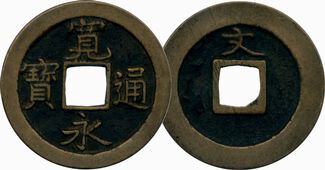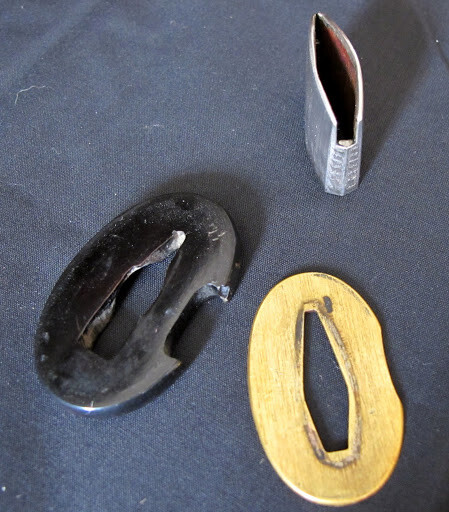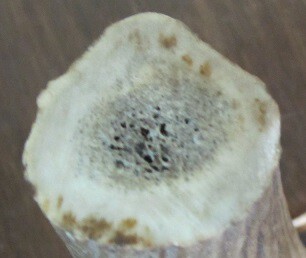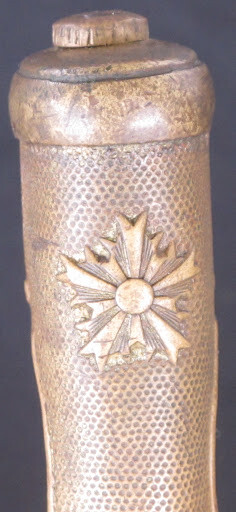-
Posts
868 -
Joined
-
Last visited
-
Days Won
2
Content Type
Profiles
Forums
Events
Store
Downloads
Gallery
Everything posted by Lee Bray
-
I'm having trouble translating this mei that was posted on another forum. I have permission to repost the owner's photographs here for a proper translation. I see ten kanji and read them as - X Tachibana Iga (no) Kami Nyudo Minamoto Mitsuhira. Could someone kindly please fill in the blank and correct any mistakes? Cheers.
-
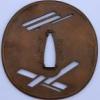
Dai Tôken Ichi 2013 photos
Lee Bray replied to Guido's topic in Sword Shows, Events, Community News and Legislation Issues
Yes, Gendaito are offered at some stalls. If memory serves, when I last went three years back, there was a full stall dedicated to WWII katana. Well worth the trip, George. -
Based on the Japanese one mon coin of the early Edo period, which was derived from Chinese coinage. What your item is, I have no idea.
-

Bad experince with Aoiart Japan.
Lee Bray replied to Kai-Gunto's topic in Auctions and Online Sales or Sellers
Not related to the topic but bank transfer is much cheaper than paypal when you get over a certain price, as the transfer is a set fee rather than paypal's percentage. I'd also think transfer between banks is much less prone to issues than a paypal transaction between email addresses. -
Like, all tsuba look really, really lovely with acid enhancement, man. Or are you talking about using the acid on the tsuba?
-
I have one in black. Mine is water buffalo horn. Don't think yours is buffalo but maybe ivory? The 'spongy' looking centre is natural and I guess is the new growth area where the dead hair cells 'go' on a living horn/tusk, being that the outer wall and towards the tip is generally fairly solid. Here's a cross section of an antler I have to show what I mean. Mine is mounted on a small, Sue Koto shobu Bizen wakizashi, like a hamidashi tsuba. I don't think the buffalo horn ones are so rare but not seen one in your material unless you count the carved bone tourist tanto you see often.
-
Definitely police? I don't know much about these dirks/tanto but I owned a police issue Meiji period tanto once and it had the attached insignia on the handle, which Hamish's appears to be missing. It's probably the overcleaned brass and etched hamon but I get a funny feeling on this one. Some elements seem ok but some don't. Strange one. Wish I could be of more help, Hamish.
-
I still enjoy my Shigetaka despite its (now)obvious gimei, fake papers and that I paid slightly over 2kUS because it had kicho papers when I was less informed. The seller was a caucasion in HK who bought the sword when stationed in Tokyo 30 years prior to me buying it from him several years ago. He wasn't a collector, just wanted a memento from his trip - the sword had been left unoiled since his small bottle of oil that the original dealer gave him had ran out. He'd even taken sandpaper to the blade to remove the worst of the rust(minimal) slightly prior to me buying it. I hold the seller in no way accountable for the 'mistake' that I made. He was not a collector, didn't claim to be and was obviously not from our meetings, although he was a thoroughly amicable and genuinely nice guy. He thought he had a genuine package and sold it as such. Caveat emptor. With hindsight, I'd have bargained him down more, but certainly not dismissed the blade because of the papers. With more Nihonto knowledge, I'd have bargained more because it was a 6th gen Shigetaka wakizashi. If I'd known it was gimei, I'd still have bought it but would have tried to be ruthless with the price. As it is, I count it as a lesson. Regarding your point C, if you have to ask about ethics, I feel you're already skirting your own personal ethics. Point D...depends entirely on the blade.
-
Rust is easily fixed by a layman at home. Suriage needs tools and a degree of skill. If this was an attempt at suriage, it was done by a monkey with a rock...possibly trying to keep Stephen's rats away...
-
I like that cord wrapped saya. It's made up of half hitches and finished with a Turk's head knot. The maker dressed his knots well as it all looks very uniform and neat. You get to imagine that was done on a very long, slow boat home...
-
Both mei and nengo are done in the same hand plus the sword characteristics don't tally with Echizen Shigetaka works, though I've only compared it with the first three generations as the sixth is impossible to find. I think it's a clear case of gimei. I would love to find out who made it but if I had the grand or so it would cost to remove all the mei and resubmit, I'd prefer to give it to Grey for some books I'm missing.
-
Hi Ed. Good topic. It will/would be interesting to see the percentage of resubmitted blades passing hozon at the same attribution as the previous kicho papers. I get the feeling you won't get a true figure, regardless how many respond. A few reasons: - the blade is obviously gimei; removal of mei being reasonably expensive and therefore whole resubmission process becoming more than the blade's worth or the owner can afford. (my own bias against kicho papers - viewtopic.php?f=1&t=8593&p=75087&hilit=Shigetaka#p75087) - owners not wanting to spend the money. - owners not wanting to be told otherwise(took me awhile ) - owners not wanting modern official record that their 'Masamune is not real. - knowledgeable Japanese saying that kicho papers are called "certification of Gimei/Gibutsu" - viewtopic.php?f=3&t=16989&p=149712&hilit=kicho+fake+papers#p149712 Essentially, if you're in this hobby for cash, kicho papers are great. If you're in it for knowledge, education and preservation, then it seems that many kicho papers are not reliable. That many are unreliable, unfortunately, throws the good ones under the bus, as well I'll be interested in how many documented examples are out there.
-
Most Gassan works have a nakago that show a very high level of skill and attention to detail. The mei shows that same attention to detail and is very artistic, like very good calligraphy. Your sword doesn't show that to me. You generally shouldn't judge a sword on its mei, but Gassan works are somewhat of an exception to that, at least to my mind anyway. A good example - http://www.nihonto.ca/gassan-sadayoshi/
-

The Chinese are faking showa-to now
Lee Bray replied to brannow's topic in Auctions and Online Sales or Sellers
Neither was I. -

The Chinese are faking showa-to now
Lee Bray replied to brannow's topic in Auctions and Online Sales or Sellers
There are fully mounted and properly(? - at least they display hamon) heat treated katana coming out of the forges in China which retail for way under US$200. That's retail prices in the US, so with shipping from China and profit margins, the Chinese forges are selling them for less than $100. This copy of a Shingunto - http://www.youtube.com/watch?v=M2zgYN35Id4 - retails for US$350. It's not perfect, no, but a lot better than the vast majority of obvious fakes we see. Actual cost would be what, $150-$200? So, I think you're right in that the manufacturing costs would be higher but I don't think by very much. I think we've just been lucky so far in that the sword market is small and generally well educated and the Chinese haven't taken full advantage of it. With handbags, watches, DVD's, etc, there is so much more money to be made for a lot less hassle. Hopefully, with increased wealth across China and their promised political reforms, we might see a decrease in all forms of Chinese fakes but then we might also see flying pigs... -

The Chinese are faking showa-to now
Lee Bray replied to brannow's topic in Auctions and Online Sales or Sellers
They used to say there was a sucker born every minute. With the exponential growth rise in population, it's probably closer to every second, nowadays... -

The Chinese are faking showa-to now
Lee Bray replied to brannow's topic in Auctions and Online Sales or Sellers
If you check the sellers other items, you'll see he's selling a copy of Fuller & Gregory's Military swords. Maybe that's where the improvements have come from and now they don't need the book... Considering that some forges in China have been making decent production katana for some years, I'm surprised it has taken this long to see fakes of this 'quality'. It does seem that there are still plenty of people who will pay out good money for blatantly obvious fakes so maybe they haven't needed to yet. -

Koshirae for a Meiji ere blade
Lee Bray replied to CurtisR's topic in General Nihonto Related Discussion
Fred Lohman is for modern production swords, not for Nihonto. Even in that field he receives complaints. You can view a modern assembled koshirae(with antique pieces or modern made ones) as a money losing venture or you can view it as supporting the craftsmen who continue the traditions. My sword mentor has had new koshirae made in Japan from antique pieces and seems more than happy with them. Nothing wrong at all with collecting kodugu in boxes but it's nice to see them mounted on what they were made for as well. -

hamon outline in hadori polish
Lee Bray replied to george trotter's topic in General Nihonto Related Discussion
Logic and art...such a compatible mix... -

hamon outline in hadori polish
Lee Bray replied to george trotter's topic in General Nihonto Related Discussion
The mechanics of any polish determine the "look" of the hamon, no? George, we know your preferences. Some of us are in agreement, depending on the sword. Sashikomi can be manipulated; just read 'The Art of Japanese Sword Polishing' by Setsuo Takaiwa to see how. A vinegar etch of the whole blade could be construed as a 'sashikomi' polish. Is that what you want to see? -

hamon outline in hadori polish
Lee Bray replied to george trotter's topic in General Nihonto Related Discussion
Because it can't. -

hamon outline in hadori polish
Lee Bray replied to george trotter's topic in General Nihonto Related Discussion
Wasn't this blade established as a non traditional Showato? As such, a proper polish would be worth more than the sword so maybe the client, the polisher or both didn't think it was worth the time to do a proper polish. -
Ford is currently running an intensive month long teaching course so may not be reading this but Sage is correct. He stated as much on his facebook page some time ago.
-
Ed - I used to own a Showato with the same W stamp as yours that was signed Hisamichi(nijimei) and dated May, 1945. It came in the remnants of the late 1944 pattern mounts. It was fairly short, about 25 1/2", IIRC, with a second mekugi ana at the butt of the nakago. There was a W stamp in the standard area for a stamp and also one on the mune. Never found out what the stamp meant, unfortunately, so no help there but just thought this info might be an extra clue.




